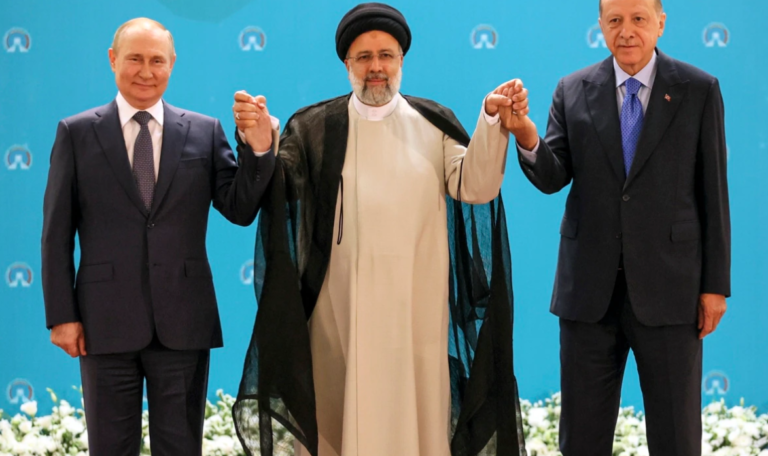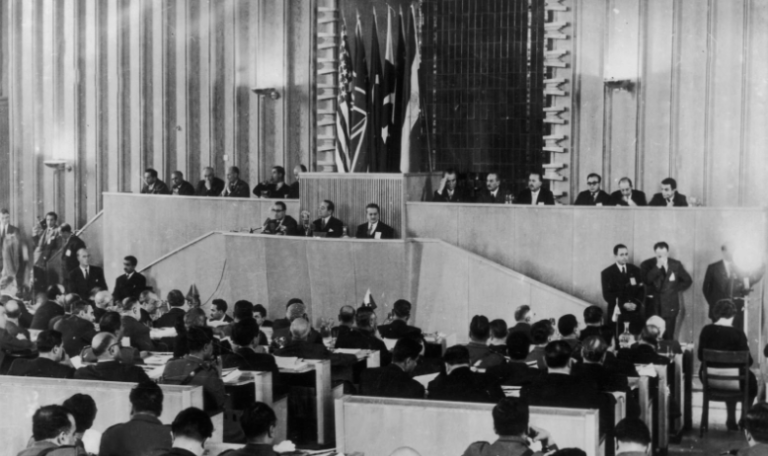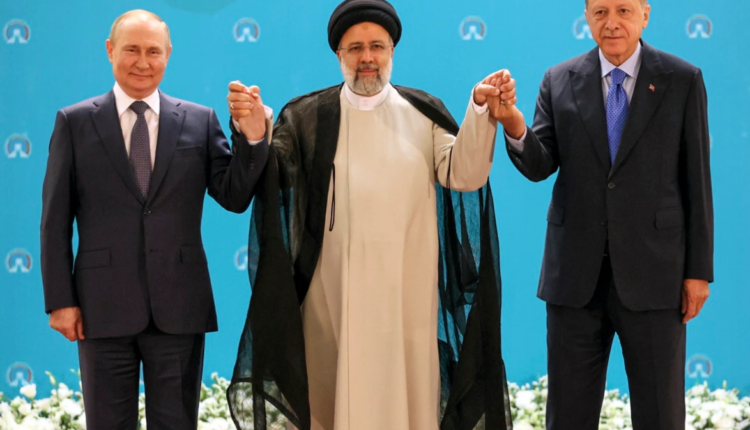Nadum Jwad*
ITRODUCTION
Many observers of the Middle East political scene believed President Joe Biden July visit to Israel and Saudi Arabia would result in the formation of a new CENTO against Iran. However, few have reflected on the possible consequences of Tehran summit. This paper will dwell on this event. .Iran, Turkey, and Russia have a long list of grievances against Washington but with diverging views and interests (Iran, Turkey, and Russia) held a meeting in the Iranian capital Tehran to discuss some hot issues such as the war in the Ukraine, the situation in Syria, grain shipments, and fight against terrorism, among other issues. This writer believes that the meeting has all the marks of a possible alliance between these countries (with potentially China and to a lesser extent Pakistan) which will mirror the CENTO alliance of the 1950’s at the heights of the cold war, united by their desire to counter American hegemony.

Russian President Vladimir Putin, Iranian President Ebrahim Raisi, and Turkish President Recep Tayyip Erdogan pose for a photo prior to their talks at the Saadabad Palace in Tehran on July 19. (Photo via AP)
THE CENTO ALLIANCE
The Central Treaty Organization (CENTO), which was the successor to the Baghdad pact, was a military alliance of the Cold War. It was formed in 24 February 1955 by Iran, Iraq (withdrew in 1958), Pakistan, Turkey, and the United Kingdom. The alliance was dissolved on 16 March 1979 after the Iranian revolution. US pressure and promises of military and economic aid were key in the negotiations leading to the agreement, but the United States could not initially participate. John Foster Dulles, who was involved in the negotiations as United States Secretary of State under President Dwight D. Eisenhower, claimed that was due to “the pro-Israel lobby and the difficulty of obtaining Congressional Approval (Selwyn Lloyd; Suez 1956: A Personal account.) n 1958, the US joined the military committee of the alliance. It is generally viewed as one of the least successful of the Cold War alliances. (Martin, Kevin W. (2008). “Baghdad Pact”. In Ruud van Dijk; et al. (eds.). Encyclopedia of the Cold War. New York: Routledge. p. 57. ISBN 978-0-415-97515-5. Retrieved 2009-01-30.) Two of the countries which were part of the former CENTO alliance (Iran and Turkey) were part of the meeting in Tehran. And in the case of Turkey, it is a member of NATO since 1952 which was establish solely to counter the former Soviet Union, which in turn established the Warsaw pact less than three months later to include the former Czechoslovakia, Bulgaria, Hungary, former East Germany, and Poland (Romania and Albania who joined initially withdrew in the late sixties.)

A picture of a meeting of the CENTO Alliance (Getty image)
The CENTO (and its predecessor the Baghdad Pact) alliance was created at the climax of the cold war, and as the two superpowers at that time were busy attracting countries around the world to its respective sphere of influences. And it was common to see countries are members of one alliance or another (Southeast Asia Treaty Organization (SEATO), which was formed in 1954 when the United States, France, Great Britain, New Zealand, Australia, the Philippines, Thailand, and Pakistan formed the Southeast Asia Treaty Organization, or SEATO (US Department of State, Office of the Historian.) This polarization prompted some newly independent countries in Asia and Africa to hold the Bandung conference in 1955 with stated aims were to promote Afro-Asian economic and cultural cooperation and to oppose colonialism or neocolonialism by any nation. The conference was an important step towards the eventual creation of the Non-Aligned Movement (Bogetić, Dragan (2017).
There is a lot of similarities between the current global atmosphere of polarization and that existed after the second world war manifested by the expansion of NATO and the attempt to entice new countries to join in such as Finland, Sweden (and possibly the Baltic states of Latvia, Estonia, and Lithuania), and of course Ukraine which the was the trigger behind the current crises. Adding to this is the attempt on to build a pseudo alliance between the USA, Iraq, Jordan, Egypt, Saudi Arabia, UAE, Oman, Bahrain, Qatar, and Kuwait against Iran. During this summit president Joe Biden declared “we will not walk away and leave a vacuum to be filled by China, Russia or Iran,” Biden said. “We will seek to build on this moment with active, principled, American leadership” (The Guardian, July 16, 2022.) This is in addition to the Aukus alliance in which UK, US and Australia announced a historic security pact in the Asia-Pacific, in what’s seen as an effort to counter China. This alliance is probably the most significant security arrangement between the three nations since World War Two, analysts say. The pact will focus on military capability, separating it from the Five Eyes intelligence-sharing alliance which also includes New Zealand and Canada. While Australia’s submarines are the big-ticket item, Aukus will also involve the sharing of cyber capabilities and other undersea technologies ((BBC September 15, 2021.) It is also worth mentioning that US President Joe Biden says he would use force to defend Taiwan if it was attacked by China, appearing to signal a shift away from Washington’s decades-long policy of so-called strategic ambiguity towards the East Asian democracy. Biden made the remarks while visiting Japan (Aljazeera May 23, 2022.)
It is noticed from the above that the immediate goal of the USA is to contain and combat Chinese influence across the globe. This article will focus on the meeting in Tehran and the possible alliance between the three countries and investigate the possible current or future rule China will paly directly or indirectly which is widely expected. And as Arai of London commented on July 19, 2022 “this summit will serve as a stage to build a new alliance between Turkey, Iran, Russia, and will most certainly include China”
The Tehran Conference:backgrounds, and analyses
The meeting between the presidents of Iran, Turkey, and Russia took place on the 19th of July 2022 and was reported widely. It came on the aftermath of the Jeddah summit between the USA and some middle eastern countries. The Russian President Vladimir Putin, went to Iran in a show of deepening ties between the two nations, united in their isolation from the West. Putin admitted Monday in a meeting with government officials that Western sanctions had created “colossal” difficulties for the Russian economy. He has sought to expand trade with China, Asia, and the Middle East to make up for plummeting imports from the West. In his meeting with the Iranian president Raisi, he extolled growing trade ties with Iran, sending a message to his Russian audience that while Western companies have left the country in droves, Moscow still has reliable friends. “We can boast of record figures in terms of trade growth,” Putin said. Putin also discussed trade, energy, transportation, and the conflict in Syria in his meeting with the Iranian leader is emerging as a key ally of Moscow. He then met with Turkish President Recep Tayyip Erdogan. Later in the evening, he held talks with both Raisi and Erdogan (The Washington Post July 19, 2022.)
The three countries on the surface have many interests in common, but certainly have several converging points also such as the war in Ukraine which greatly Turkey’s supplies of grains. As the Washington Post reported on July 19, 2022 “A trilateral meeting of the leaders of Iran, Russia and Turkey seemed to suggest a new anti-American alliance. But there are major fissures between the countries, too.” It went on to add “While the United States likes to wrap its alliances in grandiloquent words about shared values and democracy, Russia, Iran and China, Moscow’s other openly supportive pal and American rival, are far more transactional in their connections. But transactional relations do not make for lasting alliances or disguise the strains within them.”
As it will be explained, the war in Syria whereas the three countries have military presence remains the biggest irritant between the three countries. To that, and as the BBC reported, the supreme Iranian leader Khamenei and during his meeting with Turkish president Erdogan, he reminded him that any military operation there will damage Syria, Turkey, and the whole region. He added that the planned Turkish move against the Kurdish PKK in Syria will most benefits the “terrorists”
and on Syria, Russia, Iran and Turkey to olve thier diffrences thruogh dialogue (BBC July, 20.)
Although the final communique of the summit expressed the three countries determination “to cooperate to defeat terrorists in Syria”, their refusal to create conditions on the grounds as pretexts to fight terrorism which include imposing illegal autonomous entities and separatist movements, protect the territorial integrity of Syria, in addition to threatening the national securities of neighbouring countries, it is the belief of this writer that many problems remains between them especially the war in Syria. From his perspective, Erdogan has invested son much in the fight against the PKK and his desire to create a “safe zone” on the boarder between Syria and Turkey must be achieved. It is also unlikely that all the issues between Iran and Turkey can be solved in one summit given the two countries conflicting interests in Syria and to some extent in Iraq. But Erdogan is a practical operator and knows when and where to play his cards. His upcoming elections, the worsening economic conditions in his country, the fall of the Turkish Lira, the endless war with the PKK, prompt him to accept what was achieved in the meeting, and maybe the solution to the grains issue was the minimum he could be satisfied with. The rest is to be seen.
The relations between Russian, Iran, and China

The leaders of Russia, Iran, and China in 2018 (Getty Pictures)
The military corporation between Iran, Russia, and China has been going on for a while and is getting stronger since the Trump administration cancelled the nuclear deal with Iran. For instance, it was reported that on June 9, 2018, Chinese President Xi Jinping opened a two-day regional security summit attended by Russia, Iran and other allies confronting at that time the rising tensions with the US over trade and Washington’s withdrawal from the Iranian nuclear deal. Those who attended four former Soviet Central Asian republics, Pakistan, and India. Iran is an observer (Taipei Times, June 10, 2018)
On December 30, 2019, the China Daily reported the on Friday, December 27, military forces of China, Russia and Iran began a four-day naval exercise in the Gulf of Oman and the Indian Ocean. Code named “Marine Security Belt,” the trilateral exercise is aimed at enforcing regional order and balance. The idea is to assess the capability and preparedness of the three naval forces, exercise surveillance, identify deficiencies in a region that itself, in security terms, appears to be in unprecedented decline.
In January 2022 Iran, Russia and China conducted a joint naval drill in the Indian Ocean aimed at boosting marine security, state media reported. This was Iran, Russia, and China third joint naval drill in the northern Indian Ocean, amid speculation that the three countries are teaming up in the face of growing regional tensions with the United States. Russian vessels, together with the Chinese and Iranian navies, performed “joint tactical maneuvering and practiced artillery fire at a naval target as well as search-and-rescue missions at sea,” the Russian Defense Ministry said on January 21, adding that the sides also “practiced inspection and liberation of a ship that was supposedly captured by pirates.” Eleven Iranian vessels were joined by three Russian ships and two Chinese vessels, Iranian Rear Admiral Mostafa Tajoldini earlier told state TV. Iran’s Islamic Revolutionary Guards Corps (IRGC) are also participating in the exercises, with smaller ships and helicopters. Since coming to office in June 2021, Iran’s hard-line President Ebrahim Raisi has pursued a policy to deepen ties with both Moscow and Beijing. Russia, Iran, and China are subject to Western sanctions imposed over various issues, including Russia’s threats on Ukraine’s territorial integrity, human rights abuses in China, and Iran’s nuclear program (Radio Free Liberty, January 21, 2022.)
China’s reaction to the summit is rather predictable, any block against the USA is welcomed. The Jerusalem Post commented on July 23, 2022 “the tripartite meeting in Tehran last week of Russia, Iran and Turkey has caused reverberations around the region – and may have global ramifications due to the mutual interest of the three authoritarian nations in undermining US hegemony. These states have said openly that their goal is a multi-polar world, each of them with its own agenda and interests. It is worth briefly reviewing some of the outcomes of the get-together. One potential impact is that the meeting of the three countries may empower China to pressure the United States. “Beijing has its own reasons to want to challenge the US, but as China watches Turkey, Russia and Iran working together, it may decide that it has new opportunities. Beijing knows that Washington can only deal with so many crises at the same time. One issue where China is exploiting global tensions is in its reaction to the potential visit of a US delegation to Taiwan, including House Speaker Nancy Pelosi, and American military support for Taipei City.” Of course, the Taiwan’s issue is highly sensitive to the Chinese, and it is a permanent irritant in the relations between the two global giants. And this visit comes in aftermath of what president Biden stated about his readiness to use force to defend Taiwan.
CONCLUSIONS
This writer believes that Russia, Iran, and Turkey will form a sort of loose alliance like the former CENTO alliance in the 1950’s. And like the CENTO alliance whereas the USA was not a full member but a willing observant and participant, China will have the same role. The writer also believes that, again like the CENTO alliance before, Pakistan will join the new alliance if Imran Khan returns to power (his party, PTI, scored a decisive victory in a by-election in Punjab, and he is calling for an early election, The Economist July 21, 2022) and knowing his very close relations with China and his public criticism of the USA and condemnation of Israel. This, if happened, will be so ironic as three of the previous members of the former CENTO alliance (Iran, Turkey, and Pakistan) will also be members of this preserved alliance, but for different reasons. And as the old CENTO alliance members were united in their fear of communism, the members of the new alliance will be united to counter American hegemony. It is worth noting and as it was noted early in this article, the former CENTO alliance is generally viewed as one of the least successful of the Cold War alliances, it remains to be seen how effective this new alliance will be, although several indications points towards that it will. This is due to the fact that two of its members are superpowers (if China joins formerly) with a huge bags of what seem to be permanent disagreement points with the USA, the animosity between Iran and the USA which will get worst as the midterm elections in the USA and the elections in Israel (and next year’s election in Turkey), and the very public Turkish disagreement with the USA over Syria. In politics, however, and as it has been seen many times before, nothing is permanent, and circumstances could change at a shorth notice. And if we use the final communique of the summit and the diverging visions between the parties on the Syrian issue as an example, then we can conclude circumstances could change abruptly.
Nadum Jwad* is a freelance political commentator who lives in Windsor, Ontario, Canada


